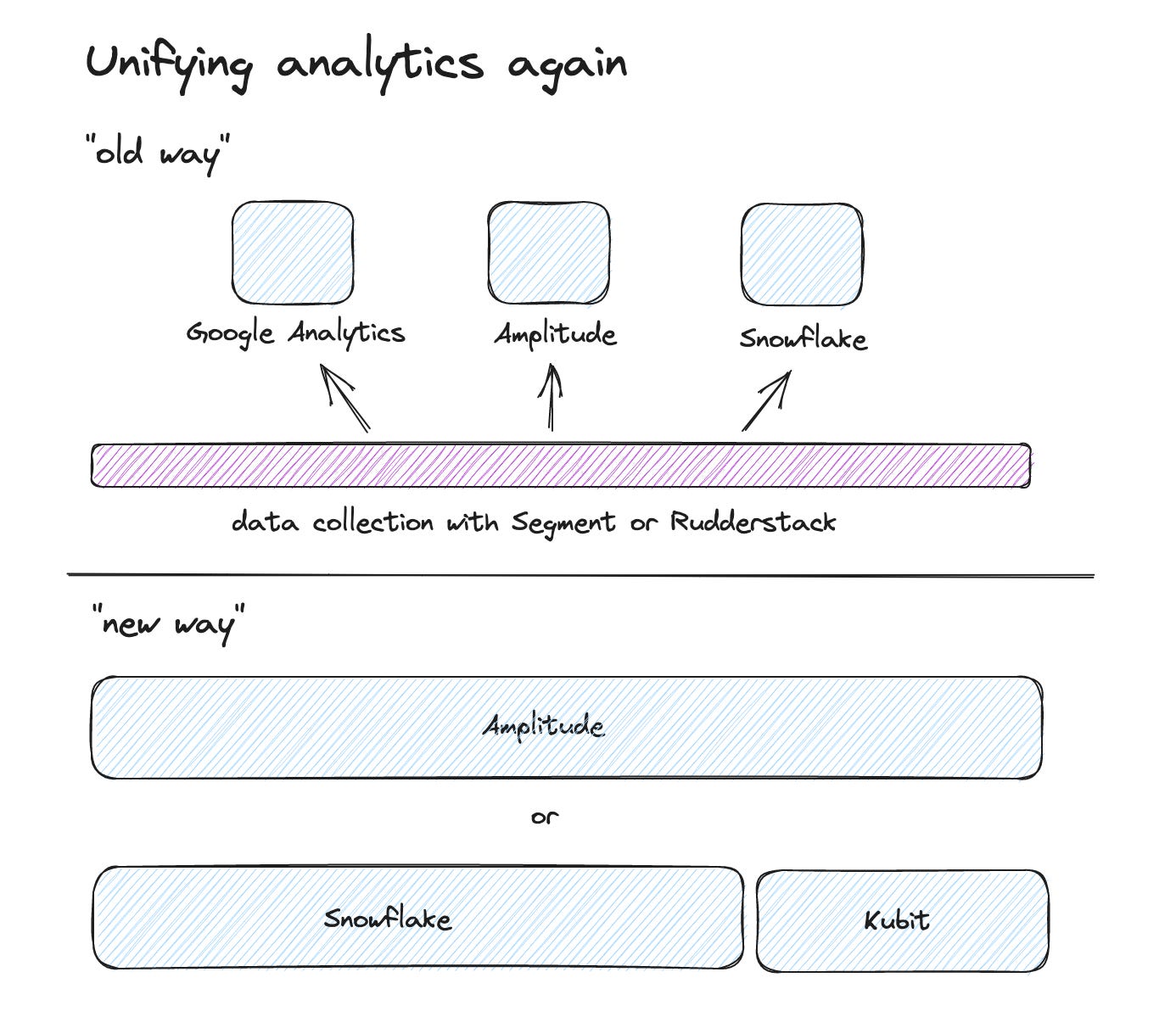
Metadata
- Author: Timo Dechau
- Full Title:: Leaving Product Analytics
- Category:: 🗞️Articles
- Document Tags:: Data Culture, Data Culture, Product Analytics And Sequence Analytics
- URL:: https://substack.timodechau.com/p/leaving-product-analytics
- Finished date:: 2023-08-27
Highlights
Product analytics is based on event data that is sent when users or systems perform a specific action (View Highlight)
This was a missing core feature for me in the past when I was talking with growth teams, since they need both parts: analyze the product usage performance and where the user came from and how many touchpoints they had during their lifetime. This use case is clearly beyond classic core product analytics, and it is something we usually call marketing analytics. So Amplitude offers both now, and you can combine them (View Highlight)
First, they target a different ICP: the product engineer (View Highlight)
Kubit and Netspring are trying to solve something I have been waiting for for years now. Product analytics on top of your events in your data warehouse. No more weird data loadings and enrichment (where most of them never worked). And mostly, no two setups for classic BI and product analytics use cases (View Highlight)
The major use case for analytics for a website is for marketing and analyzing their campaign performance (View Highlight)
Product teams are the most quantitive data-avoiding teams I know. And to be honest. I don’t really have an explanation for it. It is a post by itself to investigate it. So, for now, based on my experience and the experience of plenty of data people, getting product teams to work with product analytics is a tough job. (View Highlight)
But what Amplitude and Mixpanel did is a visible move. Yes, you can still read product on their websites (which is important), but Amplitude now calls itself a digital analytics platform, and Mixpanel speaks of analytics for everyone. (View Highlight)
And this might already be a part of the answer, which is why it is so hard to work with them. You can develop a good product by simply working only with qualitative data (View Highlight)
Who needs Product Analytics And Sequence Analytics, particularly growth teams and product teams.
Marketing analytics is straightforward. You define your customer journey funnel - which is usually defined by 5-7 core events. You track them and ensure all marketing campaigns that link to your website have tracking parameters. And then, you analyze the campaigns across this funnel. Your main concern then is how you handle attribution (to be fair that can be a real pain (View Highlight)
In product analytics, there is no simple funnel (View Highlight)
a core optimization metric for the product is how users return since most products nowadays are built on subscriptions. For this, you need to understand how cohort analysis works and this is quite a complex topic to get your head around (View Highlight)
Growth teams and even better ones focusing on Product-led growth. They have some roots in product development, but their main focus is on growing the user base and, finally, the subscription base of a product. To do this, they need fast feedback loops and are naturally more metrics-driven than classic product managers. But they need something that classic product analytics could not offer: marketing attribution (View Highlight)
No one really knows for whom the solution is built now. Google Analytics was always the best out-of-the-box tool for marketing analytics. You can still do similar things but it does not feel out-of-the-box anymore. (View Highlight)
There is an opportunity for products to offer an advanced version of Google Analytics with a consistent product design. Something in between Google Analytics and Adobe Analytics (View Highlight)
the deep Google Ads integration is not the biggest asset anymore since marketing channels were diversified more than 5 years ago. (View Highlight)
Now you can import specific marketing cost data automatically into Amplitude and work with it. (View Highlight)
These features now enable growth teams to work with a tool like Amplitude since it provides the missing pieces of the former puzzle. But it also makes Amplitude a pro tool for marketing analysts since Amplitudes funnel and cohort analysis and even data tables are more powerful than the Google Analytics version (View Highlight)
Session replays are also undervalued. When I worked in product, my data stack was always at least a product analytics tool and session replay tool. I then had to make sure that ids are exchanged between both so that I could make connections. The workflow was often like this: I discovered an interesting set of users (like some dropping off in a funnel), I went to the user explorer, picked some user ids, went to the session replay tool, looked for these sessions, and often got interesting hints what was causing the drop off by watching the replay. (View Highlight)
Why Product Analytics Is Completely Different Than Bi
you can’t use BI tools to work with event data here: (View Highlight)
Product Analytics And Sequence Analytics
Then I discovered Kubit. And they promised exactly what I wanted. Event analytics on top of my data warehouse data. And for me, this is the future I want to live in. (View Highlight)
I can collect and load events from anywhere (View Highlight)
Based on all these different events, we then model activities by selection, transformation, merging or enrichment of the event data. And this data is then used by Kubit to analyze it: All use cases, no limits. (View Highlight)
 (
( (
(